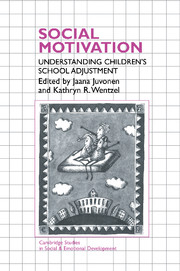Book contents
- Frontmatter
- Contents
- Contributors
- Preface
- Foreword
- 1 Introduction: New perspectives on motivation at school
- Part I Social motivation: Perspectives on self
- Part II Social motivation: Perspectives on relationships
- 9 Interpersonal relationships in the school environment and children's early school adjustment: The role of teachers and peers
- 10 Social goals and social relationships as motivators of school adjustment
- 11 Friends' influence on school adjustment: A motivational analysis
- 12 Peer networks and students' classroom engagement during childhood and adolescence
- 13 Academic failure and school dropout: The influence of peers
- 14 What's “emotional” about social motivation? A comment
- Author index
- Subject index
12 - Peer networks and students' classroom engagement during childhood and adolescence
Published online by Cambridge University Press: 22 October 2009
- Frontmatter
- Contents
- Contributors
- Preface
- Foreword
- 1 Introduction: New perspectives on motivation at school
- Part I Social motivation: Perspectives on self
- Part II Social motivation: Perspectives on relationships
- 9 Interpersonal relationships in the school environment and children's early school adjustment: The role of teachers and peers
- 10 Social goals and social relationships as motivators of school adjustment
- 11 Friends' influence on school adjustment: A motivational analysis
- 12 Peer networks and students' classroom engagement during childhood and adolescence
- 13 Academic failure and school dropout: The influence of peers
- 14 What's “emotional” about social motivation? A comment
- Author index
- Subject index
Summary
If one asks parents and teachers about important influences on children's motivation and adjustment to school, answers will likely suggest four sets of factors: the teacher and the general school environment, the psychological make-up of the individual child himself or herself, the family environment, and the child's relationships with his or her peers in school. In fact, research on school motivation and adjustment has examined all four influences. However, if one looks at current discussions of motivation and school adjustment (e.g., Ames & Ames, 1984, 1985), most research seems to concentrate on the first two factors, namely, the school and the child; some efforts target the family, and only comparatively few include children's peers.
Characteristics of schools, classrooms, teachers, and students have been prime targets of motivational studies (Skinner & Belmont, 1993). In general, it is educational researchers who have focused on school and classroom contexts (for reviews, see Ames & Ames, 1985; Brophy, 1983; 1986), such as the role of teacher behaviors, teaching styles, or evaluation strategies (Boggiano & Katz, 1991; Brophy, 1985, 1986; Graham & Barker, 1990; Grolnick & Ryan, 1987; Keller, 1983; Midgley, Feldlaufer, & Eccles, 1989; 1990; Moely et al., 1992), and the overall classroom environment and organization (Ames, 1984; Eccles, Midgley, & Adler, 1984; Johnson & Johnson, 1985).
Psychological research has focused more on children themselves (for reviews see Ames & Ames, 1984; Dweck & Elliott, 1983; Stipek, 1993), specifically on their understanding and explanations of their own role in the school environment.
- Type
- Chapter
- Information
- Social MotivationUnderstanding Children's School Adjustment, pp. 279 - 312Publisher: Cambridge University PressPrint publication year: 1996
- 55
- Cited by



